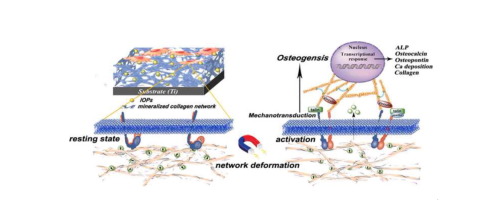Acta Biomaterialia ( IF 9.7 ) Pub Date : 2018-03-15 , DOI: 10.1016/j.actbio.2018.03.009 Junjun Zhuang , Suya Lin , Lingqing Dong , Kui Cheng , Wenjian Weng

|
Mechanical stimuli at the bone–implant interface are considered to activate the mechanotransduction pathway of the cell to improve the initial osseointegration establishment and to guarantee clinical success of the implant. However, control of the mechanical stimuli at the bone–implant interface still remains a challenge. In this study, we have designed a strategy of a magnetically responsive coating on which the mechanical stimuli is controlled because of coating deformation under static magnetic field (SMF). The iron oxide nanoparticle/mineralized collagen (IOP-MC) coatings were electrochemically codeposited on titanium substrates in different quantities of IOPs and distributions; the resulting coatings were verified to possess swelling behavior with flexibility same as that of hydrogel. The relative quantity of IOP to collagen and the IOP distribution in the coatings were demonstrated to play a critical role in mediating cell behavior. The cells present on the outer layer of the distributed IOP-MC (O-IOP-MC) coating with a mass ratio of 0.67 revealed the most distinct osteogenic differentiation activity being promoted, which could be attributed to the maximized mechanical stimuli with exposure to SMF. Furthermore, the enhanced osteogenic differentiation of the stimulated MC3T3-E1 cells originated from magnetically actuated mechanotransduction signaling pathway, embodying the upregulated expression of osteogenic-related and mechanotransduction-related genes. This work therefore provides a promising strategy for implementing mechanical stimuli to activate mechanotransduction on the bone–implant interface and thus to promote osseointegration.
Statement of significance
The magnetically actuated coating is designed to produce mechanical stimuli to cells for promoting osteogenic differentiation based on the coating deformation. Iron oxide nanoparticles (IOPs) were incorporated into the mineralized collagen coatings (MC) forming the composite coatings (IOP-MC) with spatially distributed IOPs, and the IOP-MC coatings with outer distributed IOPs (O-IOPs-MC) shows the maximized mechanical stimuli to cells with enhanced osteogenic differentiation under static magnetic field. The upregulated expression of the associated genes reveals that the enabled mechanotransduction signaling pathway is responsible for the promoted cellular osteogenic differentiation. This work therefore provides a promising strategy for implementing mechanical stimuli to activate mechanotransduction on the bone–implant interface to promote osseointegration.
中文翻译:

磁性驱动的Fe 3 O 4 /矿化胶原蛋白涂层上的机械刺激,增强MC3T3-E1细胞的成骨分化
骨骼-植入物界面的机械刺激被认为可以激活细胞的机械转导途径,从而改善初始骨整合的建立并保证植入物的临床成功。然而,控制骨-植入物界面的机械刺激仍然是一个挑战。在这项研究中,我们设计了一种磁响应涂层的策略,由于涂层在静磁场(SMF)下变形,因此可以控制机械刺激。氧化铁纳米粒子/矿化胶原蛋白(IOP-MC)涂层以不同数量的IOP和分布电化学共沉积在钛基底上。所得到的涂料经验证具有与水凝胶相同的溶胀性能和柔韧性。已证明,眼压相对于胶原的相对量以及眼压在涂层中的分布在介导细胞行为中起着至关重要的作用。质量比为0.67的分布式IOP-MC(O-IOP-MC)涂层外层上存在的细胞显示出最明显的成骨分化活性得到了促进,这可能归因于暴露于SMF时产生的最大机械刺激。此外,受刺激的MC3T3-E1细胞的成骨分化增强源自于磁致动的机械转导信号通路,体现了成骨相关基因和机械转导相关基因的表达上调。
重要声明
磁驱动涂层被设计成对细胞产生机械刺激,以促进基于涂层变形的成骨分化。将氧化铁纳米粒子(IOP)掺入矿化的胶原蛋白涂层(MC)中,形成具有空间分布IOP的复合涂层(IOP-MC),而具有外部分布IOP(O-IOPs-MC)的IOP-MC涂层表现出最大的机械刺激对在静磁场下具有增强成骨分化作用的细胞的刺激。相关基因的表达上调揭示了启用的机械转导信号通路是促进细胞成骨分化的原因。


























 京公网安备 11010802027423号
京公网安备 11010802027423号